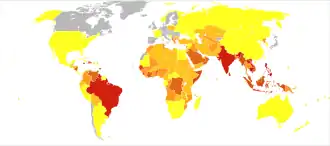Dengue fever
tropical disease caused by the dengue virus, transmitted by mosquito
Dengue fever (pronounced "Den-gee" with a hard G) is a viral tropical disease spread by mosquito bites. In 2020, the World Health Organization reported an estimate of 390 million infections per year, of which 96 million had some degree of severity. Despite a risk of infection existing in 129 countries, 70% of the actual burden is in Asia.

Dengue is a major public health problem throughout South-East Asia and South Asia. It is also found in Queensland, Australia, the tropical South Pacific, Africa, tropical parts of North and South America, including the Caribbean and mainland Central America. Estimates of the prevalence of the disease vary widely, but all show it increasing steadily since the late 20th century.
Dengue is not infectious between people. It is spread to humans mainly by the Aedes aegypti mosquito, which is found in tropical regions of the world. The Aedes albopictus mosquito can also carry it; that one tolerates cold better and has been involved in the spread of the disease to Europe and North America. These mosquitoes also carry the similar viruses that cause Yellow fever, Zika fever, Chikungunya, the West Nile disease, and several types of encephalitis.
There are five strains of the virus. After recovering from an infection, a person has long-term immunity to that strain and may for a few months be resistant to other strains.
The main preventive measures are to decrease the ability of mosquitoes to breed and to avoid mosquito bites. Vaccines are now available in some countries; see below.